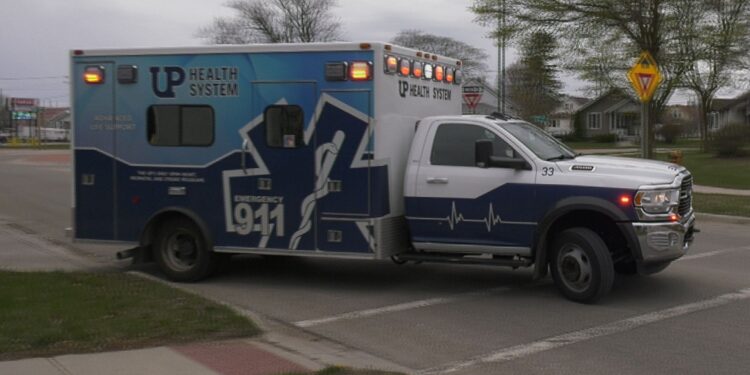ESCANABA, Mich. (WZMQ) – On Monday, a fatal crash occurred in Wells Township. According to the Michigan State Police (MSP), a truck attempted to pass an ambulance at a high rate of speed, striking another vehicle parked on the shoulder of the roadway.
Now, health and law enforcement officials are reminding drivers about the importance of yielding to emergency vehicles.
Upper Peninsula Health System (UPHS) ambulances travel more than half a million miles each year. According to UPHS Vice President of Operations Alyson Sundberg, those ambulances only turn on their lights and sirens for certain types of calls.
“If it doesn’t seem as critical based on the caller’s information, we do not respond with lights and siren,” she explained. “If it’s an unknown call or it sounds as though the person may be unconscious or it’s something life-threatening, we would respond with lights and siren. We have in the last 5 – 10 years downplayed the use of lights and siren because of folks not responding appropriately per the law.”
That law requires drivers to yield to all emergency vehicles.
“That includes fire, police, or ambulance,” said MSP Gladstone Post trooper Josiah Povich. “If the vehicle’s moving, you have to pull over to the right and stop as soon as it’s safe to do so, and that’s even for the oncoming traffic. The only difference is if there’s a physical median, like a concrete barrier or a grass strip, you don’t have to stop. If it’s just a turn lane or something, you do have to pull over and stop.”
Povich says refusing to yield is a civil infraction, punishable by a $400 fine. However, the consequences of not yielding could be even more serious.
“If we’re not able to get to a scene safely, whatever we’re going to could get worse,” he said. “Sometimes it turns out to be not that serious, but sometimes every minute does matter on some of those responses that we’re going to.”
“One person slows down response,” said Sundberg.
During an active response on the side of the road, drivers must slow down at least ten miles below the speed limit and move over one lane or two car widths if possible.
“Something we see a lot is people that go onto the shoulder but they don’t stop,” said Povich. “Sometimes they’ll be at 55 – 60 miles an hour driving down the shoulder, which is very dangerous and can cause crashes with other cars that are yielding properly.”
Sundberg says it’s also critical for drivers to pay attention to what’s in front of them when passing an active scene.
“People are more looking at what’s going on and trying to see what’s happening,” she said. “They’re not paying attention to us that are walking from vehicle to vehicle. We’re also required to wear reflective gear so that from a 360-degree angle, anybody that’s approaching us can see that reflective gear, but we have to be extra careful to watch for oncoming traffic, because they’re not looking for us.”
Sundberg urges drivers to be aware of their surroundings every time they get behind the wheel and to keep an eye—and ear—out for emergency vehicles.
“People try to multitask while they’re driving,” she said. “They’re distracted, they’re texting, they’re listening to music. Driving is a serious skill, and it only takes one time to cause a serious or fatal accident because you’re not paying attention to the road.”
Sundberg adds that caution around ambulances at all times is advised. Ambulances rarely keep lights and sirens on after bringing a patient on board to maintain as calm of an environment as possible. She says you never know if there is a patient en route to the hospital in an ambulance without its lights on.


















